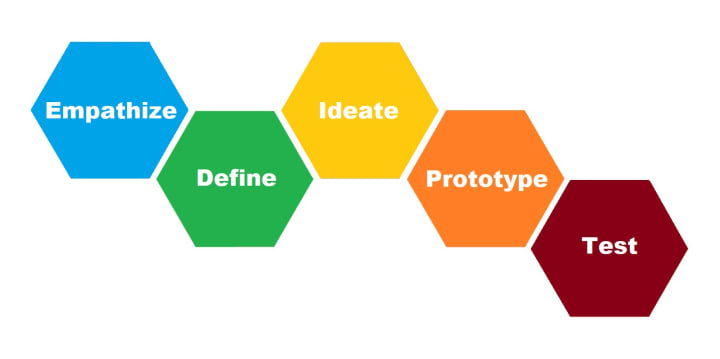Three Difficult Realizations You Face as a Design Graduate
Here's to All My Fellow Graduates, and to Holders of a Design Degree in Particular

I am sure you are just like me struggling with the oh-so-dreaded job hunt and the tons of insecurities coming from watching everyone around succeed while you have to move back into your parents’ house.
Well, no one told us it’s going to be easy. To be honest, they also didn’t tell us lots of things that they actually should have. Because here you are, facing all those horrible realizations quite unprepared.
Your degree is hollow.
Often colleges offer expensive “design programs” and award respectable degrees that give you very little in an area you might feel central to your personal ambition. Due to the vague standards and blurry curriculum, design degree (at least here in America) can mean anything from art to tech specialization. Yet what you will end up with is not entirely clear when you enter the program. Usually, it does not become clearer in the process either, as programs are pulling in all possible directions with no focus and no integrated approach.
No wonder Gadi Amit, the president of a strategic design studio in San Francisco, said that after interviewing hundreds of candidates for designer positions, he came to the conclusion that design education system is failing many aspiring young students. They think they are ready-made designers, but their understanding of underlying concepts of the design process is lacking. They have no developed aesthetic and cultural intelligence that employers are likely to expect from someone with an MA in Design.
Somebody might say that we have brought it on ourselves. After all, the college system in the US does allows you to get a Bachelor’s degree in any other field and then switch to design for your Master’s. Yet do you realistically believe that they will miraculously craft you into a savvy professional in two-years time?
Of course, you have a right to change your mind. Of course, it’s only fair that you follow your dream. Yet you must realize that this is a high-risk plan. In Europe, they would usually demand substantial design education before allowing a BA student to enter an MA program in design. In US, it is easy to make a switch but on your own head be it.
The good news? Everything is in your hands. It is up to you to complete your education, out in the field, by trial and error, working on cool projects and establishing your career path. The first five years are your true educational experience and they are crucial for your future. Make them a time well spent.
A word of advice, though. Do not treat your employer as your promotor in the “extended education college.” They expect you to deliver. So maybe those late-night learning sessions you thought you’ve left behind aren’t quite over after all.
You need experience, but you can't get any... without prior experience.

That is the dilemma of every fresh graduate—for sure. Here you are with your precious diploma in your hands that you busted your posterior to get for five long years, but it turns out this is not even enough to get you to an interview. For every tiniest entry-level position, they expect you to have at least 12 months of on-the-job nine-to-five experience. To get this experience, you must get a job, and this vicious circle seems impossible to break.
You have probably heard that you should get your first job while you are still undergraduate and even an unpaid internship is a great investment of your time into your resume and the future career. Yet if we suppose just for one moment that a broke student can afford a luxury of an unpaid internship, what about that time thing?
It’s not like design majors are having lots of fun and for days on end discuss their brilliant ideas beneath the trees on campus. No, sir. We have classes to attend, recommended literature to read, written assignments to hand in, creative projects to design, a curriculum to work on independently… for the majority of undergraduates, their studying is their full-time job. Mind you, I also had a part-time job that wasn’t anything fancy, but helped to pay the bills. On top of that, I tried to follow my passion as a writer and was active on WomenWriters and Medium.
Still, do not despair. There are jobs out there that will give you the coveted experience points. You do not hear this often, but maybe you should lower your standards. You have to start somewhere and this somewhere is probably near the rock bottom. The jobs you are looking for are low-paid. They offer zero security, as they are startups that will be closed down in exactly 12-months time—but hey, that is precisely the amount of time you need. And who knows, maybe they will skyrocket thanks to your amazing ideas instead?
Anyway, almost no one is proud of their first job. Yet without those first steps, the great positions we see as our true accomplishments never would have happened.
"Design thinking" has nothing to do with design.

As I already said, the standards for design education are blurry and most programs just try to assemble something from credit hours available at any given college and glue it together with some practical skills (say, Photoshop course). However, if you choose an established school of design that has its own vision, that’s a guarantee? Not exactly.
At some universities, they might have taught you some form of the much-hyped “design thinking,” that is essentially a linear process, crystallized in five stages: Empathy, definition, ideation, prototyping, testing. However, practicing designers, like Natasha Jen, for example, have been calling it BS for some time.
Design thinking adepts believe that its main purpose is innovation and overthrowing the old way of things. Yet the path they use is not for inventing something new. If you look at this formula closely, you will see that it is a marketing strategy:
- Define your target audience.
- Identify their pains.
- Suggest solutions.
- Implement.
- Test. (A/B, focus groups, etc.)
- …
- Profit!
It is a working model of finding out what people want and giving them exactly that. It is a problem-solving tool. This model is for getting stuff that pleases customers to market and keeping you ahead of the competition. Which is good, yet isn’t exactly the definition of “innovation” or “disruptive design.”
Natasha Jen says there are several problems with this scheme if you think of it from a practicing designer’s perspective:
- It is linear, while real creativity iterates on every stage of design
- It does not involve “crit”—only by inviting someone to critique your work, you can evaluate your design, find flaws in it, and improve it. This must be possible on every stage, not only in “testing mode.”
- It reduces the wide range of design tools to a single medium
- Most ardent adepts of design thinking mimic the startup culture and paraphernalia (hoodies, whiteboards, post-its), Silicon Valley buzzwords (affinity, customer journey, tight-loop projects, pivoting, user outcomes, getting traction, radical innovation, etc.). Also, for some reason, they have a thing for hexagons (this is probably the heritage of the geek culture).
- There is no proof that it works and improves the design process. It emerged as a methodology for human-centered industrial design, but in recent years various adjacent design fields began opportunistically latch to it in order to fulfill their own business needs.
So why the heck they were teaching you this as an ultimate way to design when most of the prominent designers used their intuition instead to focus on human needs? Maybe because it’s a trademark often associated with the fabled design and consulting firm, IDEO, famous for crafting Apple’s first mouse and the look of the Palm V personal digital assistant. This sells. Stanford four-day “Design Thinking Bootcamp” called “From Insights to Innovation” costs $12,600, for instance. No wonder everyone wants a piece of that pie. Feel cheated yet?
Still, even faced with all those difficult discoveries, I am sure you are determined to pursue the career of your dreams. You will find it to be fulfilling and rewarding. Being a recent graduate, you are entering the most difficult but also the most exciting stage of it. Think of it as a pilot that starts an awesome series. “Welcome to the real world! It sucks! You're gonna love it.”






Comments
There are no comments for this story
Be the first to respond and start the conversation.